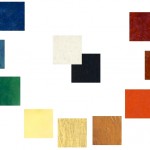How to imitate lead white in oil
March 20th, 2009
lead white
Lead white was until the late 19th century the white pigment used in oil painting. It is an attractive color and is very durable, but it is toxic and not readily available. Can we imitate it with modern non-toxic colors?
Titanium white is far more opaque, and in oil it has a gooey character. Zinc white has a working texture similar to lead white, but it is more transparent. A mixture of titanium white and zinc white can match the opacity of lead white, and has a nice working texture. Add a trace of raw sienna, and the mixture will have the warmth of pure lead white. The siena will also speed drying to match lead white.
Is it really so easy to imitate lead white? No. The character of a color is defined not only by how it appears as a pure color, but how it performs in a picture — e.g., in thin layers, in mixtures.
For example, mix lead white with a bit of black and you get a neutral gray, perfect for monochrome painting. Try the same with our modern mixture and you will get a cool gray, a color that can appear weak in some contexts. To make our cool gray neutral, more of the raw sienna would be needed. Thus, a given mixture of pigments will not suffice to match lead white under all circumstances; we need a different mixture for different situations.
These might seem like subtle differences, and perhaps they are. But in painting, the sum of subtle difference results in a not so subtle difference between sublime and lousy artwork. Which is not to say that lead white is better than the other whites, artistically speaking, but it is very different, and it is an important foundation of western art.

What were the colors of the old masters?
[22 April 2009]